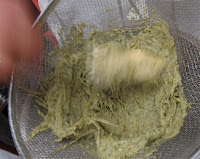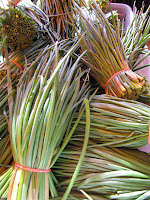Living in a vertically stacked environment I find it difficult to fully appreciate the turn of a season -- snow is gone within days – the sun is always being blocked by a skyscraper. I rely upon the farmer’s market to keep me clued into what is really happening and help switch my seasonal dial. Though weather channel does act as my secondary guide to start my search, as well as an alarm when an unexpected cold trough pushes its way back in.
Regardless, if it is a morning where a T-shirt will suffice or a light jacket needs to be thrown on before leaving I am convinced I’ll find something clinging with damp earth of spring.

Ramp wrapped Scallop – yields 4 to 6 servings
1-bunh of ramps – root hairs discarded
1-pound scallops
1/8-teaspoon freshly ground black pepper
1/4-teaspoon salt
1/8-teaspoon whole cumin seed
1/8-teaspoon sumac
1-tablespoon olive oil
Wash the ramps well. Separate the white stem from the green leaf (save the ramps stems
for another day’s sauté).
Bring about 2-quarts of water to the boil, and blanch the ramps leave for about 30 seconds. Immediately drain into a colander and run cold running water the leaves to stop their cooking.
Toss the scallops with the olive oil, black pepper, salt and sumac to thoroughly coat. Then wrap each scallop with three at a minimum of the blanched ramp leaves.
 Drizzle each parcel with a scant amount of oil.
Drizzle each parcel with a scant amount of oil.Over a high flame heat a 10-inch sauté pan, or ideally, a cast iron skillet to hot.

Cook the scallops about 2-minutes on each side.
Serve immediately.
































